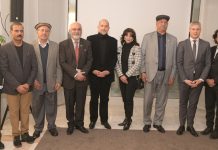By Dr. Fouzia Hadi Ali, Incharge Director, Regional Integration Center, University of the Punjab, Lahore
Introduction
Regional connectivity is the key catchword in today’s political discourse and economic activities. Therefore, to overcome the impediments in the free flow of people, ideas, and services among the countries, there is a dire need for regional integration. Besides, such divisions also hamper economic growth among the developing countries.
So keeping in view the significance of the regional integration, there was a need to establish a platform that provides long-term opportunities for the regional countries to cooperate in academic, social, economic, political, and cultural domains.
For this purpose, the University of the Punjab, Lahore, in collaboration with the Center for Global and Strategic Studies (CGSS), Islamabad, has established the Regional Integration Center (RIC) on Eurasia. The Regional Integration Center (RIC) aims to enhance the connectivity with regional countries in spheres of education, culture, media, policymaking, economy, ecology, security, technology, research, sustainable goal development, human capacity development, and lawfare.
Eurasia: The Heartland Region
A theoretical underpinning to emphasize the enhanced cooperation and relations with Eurasia can be linked to Mackinder’s “Heartland Theory” which postulates Eurasia as the core and pivot area of the Heartland and proposes that whosoever wants to rule the world has to rule the heartland. Therefore, it is imperative to explore this region, which is rich in natural resources and cultural heritage. Besides this, it is substantial to highlight the Eurasian region’s emerging significance dating back to the ancient Silk Road. The region has deep genetic, cultural, and linguistic links with the sub-continent. It comprises the continental area with several distinct peripheral coastal regions, including the Middle East, South Asia, East Asia, Southeast Asia, and Western Europe, linked by Central Asia and Eastern Europe’s interior mass.
Moreover, the three Western, Eastern, and Southern Asia regions are developed around fertile river valleys. The civilizations in Mesopotamia, the Indus Valley, and China shared many similarities, i.e., exchanged technologies and ideas. Ancient Egypt has also shared this model. These civilizations were most likely in more or less regular contact with each other by the early versions of the Silk Road.
Belt and Road Initiative (BRI) and Regional Connectivity
China has taken various regional and sub-regional initiatives to develop better connectivity within Asia. China’s Belt and Road Initiative (BRI) is a mega project directed to promote regional integration and mutual economic development in Eurasia and beyond. It aims to promote the connectivity of Asian, European, and African continents and their adjacent seas, establish and strengthen partnerships among the countries along the Belt and Road, set up all-dimensional, multi-tiered, and composite connectivity networks, and realize diversified, independent, balanced and sustainable development in these countries.BRI approach encapsulates the pillars of multiple national, sub-national, regional, and local economies. Profound and ambitious in its reach and scope to ensure complementary advantages, BRI can influence sustainable development outcomes. It passes through 80 countries that generate 40 percent of the global gross domestic product (GDP) and account for 60 percent of the world population. The energy sector is deemed as the largest beneficiary of this project that accounts for 75 percent. The acceptance reflects the desire among the states to be a part of Beijing’s successful model of economic development, peace and stability, greater prosperity, and an idea of a community of shared future. Pakistan is optimizing benefits from the China Pakistan Economic Corridor (CPEC), which is part of the larger Chinese economic strategy (Belt and Road Initiative) based on inter and intra-regional connectivity with the mega projects.
The mission of the RIC
The RIC’s mission is to attract international students, enhance academic exchange, strengthen and broaden research on regional issues and cooperation between Pakistan and Eurasia. RIC aims to become a regional integration model that it seeks to acquire by actively collaborating with regional countries in various sectors and creating joint institutions for consultation and decision-making in the region and beyond. The center will develop a concept of a shared community for regional prosperity.
RIC Vision
The Regional Integration Center (RIC) envisions a prosperous, inclusive, resilient, and sustainable region with strengthened relations with the regional states to act as a bridge between Pakistan and Eurasia.
Core Objectives of the RIC
- To attract international students in all departments, centers, colleges, and institutes of PU;
- To provide one-window operations to facilitate international students seeking admissions at PU;
- To initiate joint projects for mutual academic exchange and development, especially for the youth;
- To sign agreements with various academic and professional organizations;
- To organize various national and international conferences, workshops, and seminars, etc.;
- Organize various national and international conferences, workshops, and seminars, etc.;
- To introduce a research journal that publishes peer-reviewed articles relating to multifarious regional issues;
- Engaging international experts/ analysts to provide their input in global socio-political and economic domains;
- Promote cultural and linguistic ties within the region;
- To enhance cooperation in the agricultural sector;
- To excel in the multifarious research including Social Sciences, Law, Health, Education, Climate change, Peace and Security, Media, Technology, and so forth in collaboration with the regional countries;
- To develop strategies and framework to counter the future regional and global security challenges and threats;
- To study and provide possible solutions to regional disputes;
- To develop a policy cell that can guide various Eurasian countries on developing multilateral connectivity; and
- Explore the opportunities generated by BRI in the region.
RIC Mechanism
RIC has initiated a mechanism of cooperation with the neighboring states by establishing academic/research institutes with the capacity to award the graduate-level degree. RIC brings together highly qualified experts, intellectuals, analysts, and policymakers worldwide to deal with the emerging challenges and find venues of cooperation among states. Moreover, RIC is governed by Patron In Chief University of the Punjab, Lahore and will seek guidance from the Board of Advisors (Honorary Basis) for reviewing the academic and research activities of the Center. RIC has equal members from both the Center for Global & Strategic Studies (CGSS), Islamabad and the University of the Punjab, Lahore.
University of the Punjab, Lahore proudly announce Center for Global & Strategic Studies (CGSS), Islamabad as its collaborative partner for regional and international connectivity.
Also, RIC plans to engage higher education institutes and centers across Pakistan by collaborating with regional academic think-tanks, universities, and academic institutes.
This enhanced arrangement would allow to strengthening trade integration in the region by engaging relevant stakeholders. Furthermore, RIC will also initiate infrastructure programs to improve economic growth and regional integration. The collaboration would be facilitated by taking on board the Area study centers of the Pakistani universities, which would present the recommendations and suggested policy papers to the stakeholders in various subjects.
RIC will also study the socio-economic development models worldwide and identify best practices to develop an integrated model for relevant departments.
Major Projects: Activities under the RIC
The Regional Integration Center shall attract international students from the Eurasian region. It also aims to enhance academic exchange, strengthen and broaden research on regional issues and cooperation between Pakistan and Eurasia through joint Seminars, Conferences, and Roundtable Discussions with renowned regional universities. Furthermore, realizing a need for extensive research on the Eurasian Region, the center will promote research publications by publishing a research journal to make this region a single community with a shared future.
Moreover, to support academic collaborations, collaborative International Online Internship Programs are being initiated between RIC and renowned regional educational institutes. Furthermore, RIC also offers certified Courses and Diplomas in various regional languages to facilitate and enhance people to people connectivity in the Eurasian region.
Additionally, RIC’s major projects include Online and Physical lectures of famous regional scholars, establishing Chairs of regional countries in Pakistan and vice versa, and establishing a Eurasian E-Library.

















